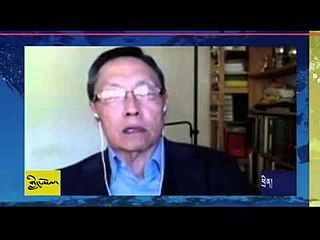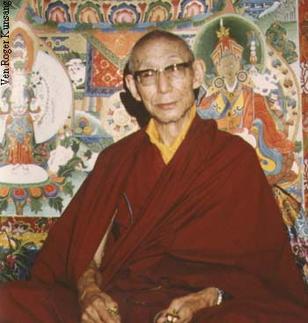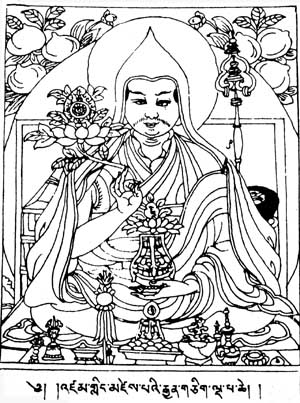
The Gelug is the newest of the four major schools of Tibetan Buddhism. It was founded by Je Tsongkhapa (1357–1419), a Tibetan philosopher, tantric yogi and lama and further expanded and developed by his disciples.

Samye, full name Samye Mighur Lhundrub Tsula Khang and Shrine of Unchanging Spontaneous Presence, is the first Tibetan Buddhist and Nyingma monastery built in Tibet, during the reign of King Trisong Deutsen. Shantarakshita began construction around 763, and Tibetan Vajrayana founder Guru Padmasambhava tamed the local spirits for its completion in 779. The first Tibetan monks were ordained there. Samye was destroyed during the Cultural Revolution then rebuilt after 1988.

Sand mandala is a Tibetan Buddhist tradition involving the creation and destruction of mandalas made from colored sand. Once complete, the sand mandala's ritualistic dismantling is accompanied by ceremonies and viewing to symbolize Buddhist doctrinal belief in the transitory nature of material life.

The 5th Dalai Lama, Ngawang Lobsang Gyatso was recognized as the 5th Dalai Lama, and he became the first Dalai Lama to hold both Tibet's political and spiritual leadership roles. He is often referred to simply as the Great Fifth, being the key religious and temporal leader of Tibetan Buddhism and Tibet. He is credited with unifying all of Tibet under the Ganden Phodrang, after Gushri Khan's successful military interventions. As an independent head of state, he established priest and patron relations with both Mongolia and the Qing dynasty simultaneously, and had positive relations with other neighboring countries. He began the custom of meeting early European explorers. The 5th Dalai Lama built the Potala Palace, and also wrote 24 volumes' worth of scholarly and religious works on a wide range of subjects.

Namgyal Monastery is in Mcleod Ganj, Dharamsala, India. It is the personal monastery of the 14th Dalai Lama. Another name for this temple-complex is Namgyal Tantric College.

GyutoTantric University is one of the great monastic institutions of the Gelug Order.

Glenn H. Mullin is a Tibetologist, Buddhist writer, translator of classical Tibetan literature and teacher of Tantric Buddhist meditation.

Lobsang Tubten Jigme Gyatso (བློ་བཟང་ཐུབ་བསྟན་འཇིགས་མེད་རྒྱ་མཚོ་), officially the 8th Arjia Hotogtu (ཨ་ཀྱཱ་ཧོ་ཐོག་ཐུ།), born 1950 in Haiyan County, Qinghai) is one of the most prominent Buddhist teachers and lamas to have left Tibet. At age two, Arjia Rinpoche was recognized by Choekyi Gyaltsen, 10th Panchen Lama as the 20th Arjia Danpei Gyaltsen, the reincarnation of Je Tsongkhapa's father, Lumbum Ghe, the throne holder and abbot of Kumbum Monastery. He has trained with lineage teachers, such as the 14th Dalai Lama, the 10th Panchen Lama, and Gyayak Rinpoche—from whom he received many sacred teachings and ritual instructions.
Namgyal Monastery Institute of Buddhist Studies incorporates two institutions: (1) the North American Seat of Namgyal Monastery; and (2) a Tibetan Buddhist theological seminary affiliated with it. The two institutions share a dharma center in Ithaca, New York. The Dalai Lama is their patron, the highest authority, and consultant.

Buddhism in the Himachal Pradesh state of India of has been a long-recorded practice. The spread of Buddhism in the region has occurred intermediately throughout its history. Starting in the 3rd century BCE, Buddhism was propagated by the Maurya Empire under the reign of Ashoka. The region would remain an important center for Buddhism under the Kushan Empire and its vassals. Over the centuries the following of Buddhism has greatly fluctuated. Yet by experiencing revivals and migrations, Buddhism continued to be rooted in the region, particularly in the Lahaul, Spiti and Kinnaur valleys.

Samten Gyeltsen Karmay (1936-) is a writer and researcher in the field of Tibetan Studies. His work is focused on the study of Tibetan myths, beliefs, the Bon religion and religious history.
Lati Rinpoche was a Tibetan Buddhist monk who was identified as a reincarnation of an earlier practitioner.

Kyabje Yongzin Ling Rinpoche is a Tibetan tulku. The best-known incarnation is the sixth incarnation, Thupten Lungtok Namgyal Thinley, a Tibetan buddhist scholar and teacher.

The Third Trijang Rinpoche, Lobsang Yeshe Tenzin Gyatso (1901–1981) was a Gelugpa Lama and a direct disciple of Pabongkhapa Déchen Nyingpo. He succeeded Ling Rinpoche as the junior tutor of the 14th Dalai Lama when the Dalai Lama was nineteen years old. He was also a lama of many Gelug lamas who taught in the West including Zong Rinpoche, Geshe Rabten, Lama Yeshe, Kelsang Gyatso, and Lama Zopa Rinpoche. Trijang Rinpoche's oral teachings were recorded by Zimey Rinpoche in a book called the Yellow Book.

The Dual System of Government is the traditional diarchal political system of Tibetan peoples whereby the Desi coexists with the spiritual authority of the realm, usually unified under a third single ruler. The actual distribution of power between institutions varied over time and location. The Tibetan term Cho-sid-nyi literally means "both Dharma and temporal," but may also be translated as "dual system of religion and politics."

(Kyabje) Choden Rinpoche was a contemporary yogi-scholar of the Gelugpa school of Tibetan Buddhism and a reincarnation ('sprul-sku') of the Choden lineage, the historical abbots of Rabten Monastery (Tibetan: རབ་བརྟེན་དགོན་པ, Wylie: in Rong-bo district, Kham.
Gankhüügiin Pürevbat was a Mongolian painter, art collector, museum director and Buddhist teacher in the Vajrayana School. Lam Pürevbat was the founder of the Zanabazar Mongolian Institute of Buddhist Art. He was born in 1965 in Bornuur in the Töv Province.

Nicholas Vreeland, also known as Rato Khensur Thupten Lhundup, is a Tibetan Buddhist monk and the former abbot of Rato Dratsang, a 14th-century Tibetan Buddhist monastery reestablished in India. Vreeland is also a photographer. He is the son of Ambassador Frederick Vreeland and grandson of Diana Vreeland, former editor-in-chief of Vogue magazine and special consultant to The Metropolitan Museum of Art's Costume Institute, where she set the "standard for costume exhibitions globally."

Chamdowa Tsawabomei Shangri Lhagyal (1921–1984) was a Tibetan resistance fighter against Chinese occupying forces in 1958–59. He was one of the commanders of the Chushi Gangdruk guerrillas, and fled to India in April 1959 shortly after the arrival there of the 14th Dalai Lama.
The Chenrezig Tibetan Buddhist Center of Philadelphia (CTBC) is a Tibetan Buddhist temple located at 954 N. Marshall Street in Philadelphia, Pennsylvania. The center was founded in 1991 by Geshe Losang Samten, a sand mandala artist who served as an attendant to the 14th Dalai Lama.
















